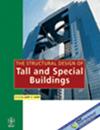Restoring force model of steel‐recycled concrete composite frame with infilled recycled block wall
IF 1.3
3区 工程技术
Q3 CONSTRUCTION & BUILDING TECHNOLOGY
引用次数: 1
Abstract
To study the restoring force model of steel‐recycled concrete composite frame with infilled recycled block wall, the experimental results of two recycled concrete‐filled steel tube frames with infilled recycled block walls and three steel‐reinforced recycled concrete frames with infilled recycled block walls under low cyclic loading were analyzed. The four broken‐line skeleton curve model which was suitable for this kind of composite frame was proposed, and the calculation methods for different stages of the skeleton curve were given respectively. According to the hysteretic characteristics of different frame specimens, the hysteretic loops for steel‐recycled concrete composite frame with infilled recycled block wall were simplified by using the treat methods of positive and negative symmetry and sudden drop of bearing capacity, and the restoring force model for different type of steel‐recycled concrete composite frame with infilled recycled block wall was established. At the same time, combing the experimental results, the proposed restoring force model was verified. The results show that the established restoring force model can predict the hysteretic behavior of steel‐recycled concrete composite frame with infilled recycled block wall well, and it can provide theoretical support for the elastic–plastic time history analysis of this kind of frame structures under earthquake.填充再生砌块墙钢-再生混凝土组合框架的恢复力模型
为研究填充再生砌块墙体的钢-再生混凝土组合框架的恢复力模型,对2个填充再生砌块墙体的再生混凝土钢管框架和3个填充再生砌块墙体的钢-再生混凝土框架在低循环荷载作用下的试验结果进行了分析。提出了适用于此类复合框架的四断线骨架曲线模型,并分别给出了骨架曲线不同阶段的计算方法。根据不同框架试件的滞回特性,采用正、负对称和承载力突然下降的处理方法,简化了钢-再生混凝土填充再生砌块墙组合框架的滞回回路,建立了不同类型钢-再生混凝土填充再生砌块墙组合框架的恢复力模型。同时,结合实验结果,对所提出的恢复力模型进行了验证。结果表明:所建立的恢复力模型能较好地预测钢-再生混凝土组合框架-填充再生砌块墙的滞回性能,可为此类框架结构在地震作用下的弹塑性时程分析提供理论支持。
本文章由计算机程序翻译,如有差异,请以英文原文为准。
求助全文
约1分钟内获得全文
求助全文
来源期刊
CiteScore
5.30
自引率
4.20%
发文量
83
审稿时长
6-12 weeks
期刊介绍:
The Structural Design of Tall and Special Buildings provides structural engineers and contractors with a detailed written presentation of innovative structural engineering and construction practices for tall and special buildings. It also presents applied research on new materials or analysis methods that can directly benefit structural engineers involved in the design of tall and special buildings. The editor''s policy is to maintain a reasonable balance between papers from design engineers and from research workers so that the Journal will be useful to both groups. The problems in this field and their solutions are international in character and require a knowledge of several traditional disciplines and the Journal will reflect this.
The main subject of the Journal is the structural design and construction of tall and special buildings. The basic definition of a tall building, in the context of the Journal audience, is a structure that is equal to or greater than 50 meters (165 feet) in height, or 14 stories or greater. A special building is one with unique architectural or structural characteristics.
However, manuscripts dealing with chimneys, water towers, silos, cooling towers, and pools will generally not be considered for review. The journal will present papers on new innovative structural systems, materials and methods of analysis.

 求助内容:
求助内容: 应助结果提醒方式:
应助结果提醒方式:


